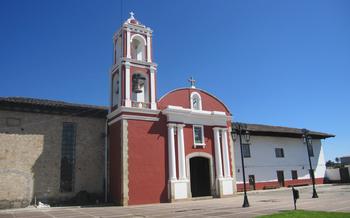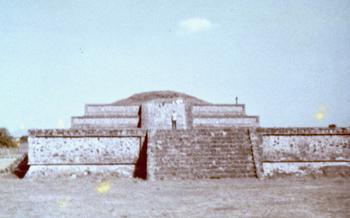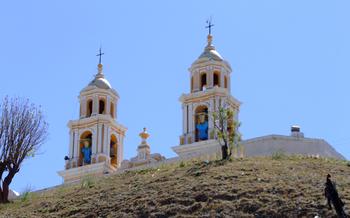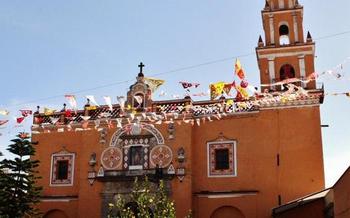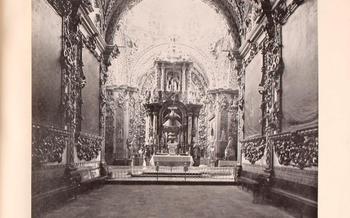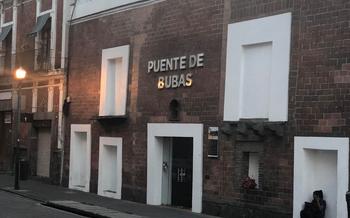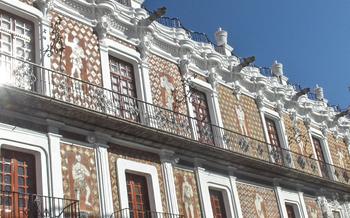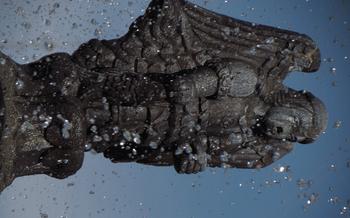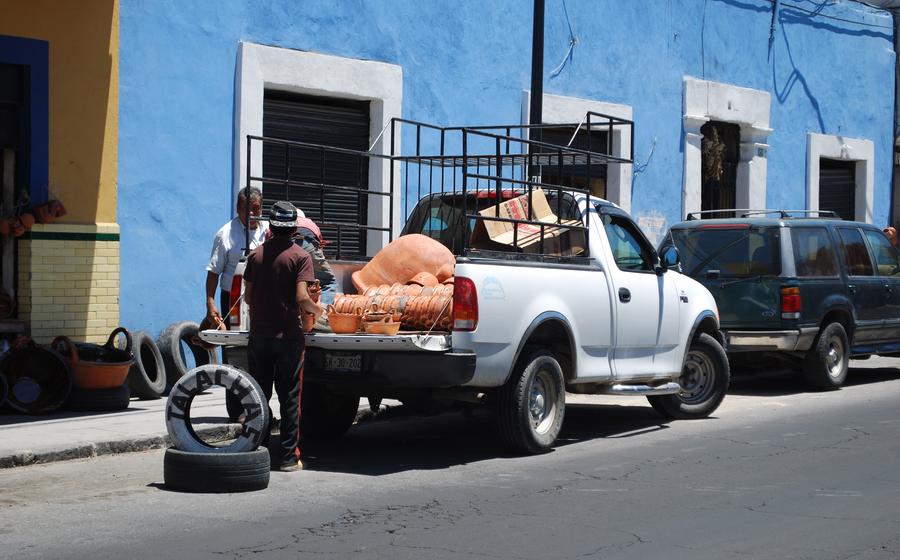
Barrio de la Luz
- Historical Background
- Strolling the Colorful Streets
- Visiting the Museo de la Talavera
- Indulging in Traditional Cuisine
- Shopping for Authentic Crafts
- Exploring the Historic Plazas
- Experiencing the Nightlife
- Discovering Hidden Gems
- Attending Local Festivals
- Learning about the History of the Neighborhood
- Supporting Local Businesses
- Respecting Local Customs and Traditions
Historical Background
The Barrio de la Luz, with its historical charm and vibrant ambiance, is a captivating neighborhood in Puebla, Mexico. Founded in the 16th century, it was built on land donated by the Spanish conquistadors to the Franciscan order. Here, the missionaries established the Templo de San Francisco and the Colegio de San Francisco, which became a prominent educational and religious center in the region. Over time, the neighborhood evolved into a thriving commercial and cultural hub, renowned for its Talavera pottery, traditional Mexican cuisine, and exquisite architecture. Today, the Barrio de la Luz stands as a testament to Puebla's rich history and cultural legacy, attracting visitors from around the world.
Strolling the Colorful Streets
Wandering through the vibrant streets of Barrio de la Luz is akin to embarking on a journey through a living canvas. The walls of the buildings are adorned with captivating street art, showcasing a kaleidoscope of colors and intricate designs. Each mural tells a unique story, reflecting the neighborhood's rich history, cultural heritage, and contemporary spirit.
Marvel at the traditional Mexican architecture that lines the streets, a harmonious blend of colonial and indigenous influences. Admire the intricate facades, adorned with colorful tiles, wrought-iron balconies, and charming doorways. Discover hidden plazas and courtyards, tranquil havens adorned with lush greenery and fountains, offering a respite from the bustling streets.
Strolling through Barrio de la Luz is an opportunity to immerse oneself in the local culture. Visit the many unique shops and boutiques that line the streets, offering an array of handmade crafts, traditional clothing, and local delicacies. Engage with the friendly locals, who are always eager to share stories and recommendations about their beloved neighborhood.
Visiting the Museo de la Talavera
The Museo de la Talavera is a must-visit attraction for anyone interested in the history and culture of Puebla. Located in the heart of the Barrio de la Luz, the museum is dedicated to preserving and showcasing the art of Talavera pottery, a traditional Mexican ceramic known for its vibrant colors and intricate designs.
The museum's collection includes over 2,000 pieces of Talavera pottery, dating from the 16th century to the present day. Visitors can admire exquisite tiles, plates, vases, and other decorative objects, each showcasing the unique skills and artistry of the Talavera craftsmen.
In addition to the permanent collection, the museum also hosts temporary exhibitions, workshops, and demonstrations, allowing visitors to learn more about the history and techniques of Talavera pottery. Visitors can witness firsthand the intricate process of creating these beautiful ceramics, from the initial molding of the clay to the final firing and glazing.
The Museo de la Talavera is not only a showcase for Talavera pottery but also a celebration of Mexican culture and heritage. The museum's collection and educational programs help to preserve and promote this traditional art form, ensuring that it continues to thrive for generations to come.
Indulging in Traditional Cuisine
Puebla's culinary scene is a vibrant tapestry of flavors and aromas, boasting a diverse range of traditional dishes that are sure to tantalize your taste buds. Mole poblano, a complex and rich sauce made with various chilies, spices, and chocolate, is the city's signature dish and a must-try for any foodie. Savor the succulent Chiles en nogada, a dish of poblano peppers stuffed with picadillo (a mixture of ground meat, fruits, and spices) and topped with a creamy walnut sauce and pomegranate seeds.
For a taste of traditional street food, head to one of Puebla's many mercados, or markets. Here, you can sample tacos al pastor, a delicacy consisting of spit-roasted pork served on a tortilla with pineapple, cilantro, and onion. Don't miss the Cemitas, a local sandwich made with a fluffy sesame seed bun, filled with your choice of meats, cheese, and vegetables.
To truly immerse yourself in the culinary delights of Puebla, consider taking a cooking class. Learn the secrets of preparing authentic Mexican dishes from local experts, and savor the flavors of your creations.
Must-try Restaurants: - La Poblanita: A renowned restaurant serving traditional Puebla cuisine in a charming setting. - El Mural de los Poblanos: A family-run eatery famous for its mole poblano and other regional specialties. - Casa de los Muñecos: A historic restaurant housed in a 16th-century mansion, offering a fine dining experience with a focus on traditional Puebla cuisine.
Shopping for Authentic Crafts
Strolling through the vibrant streets of the Barrio de la Luz, you'll stumble upon a treasure trove of authentic Mexican crafts and souvenirs. Talavera pottery, with its vibrant colors and intricate designs, takes center stage, showcasing the neighborhood's rich artistic heritage. Explore the many shops and workshops dedicated to this traditional craft, where you can witness skilled artisans meticulously hand-painting each piece.
From hand-embroidered textiles boasting colorful motifs to traditional Mexican crafts like alebrijes (fantastical painted sculptures) and papel picado (decorative paper banners), the Barrio de la Luz is a haven for those seeking unique and meaningful souvenirs. Discover hidden gems tucked away in small boutiques and galleries, where local artisans showcase their creations.
Whether you're looking for a one-of-a-kind piece of Talavera pottery to adorn your home or a handmade textile to add a touch of Mexican flair to your wardrobe, the Barrio de la Luz offers an unforgettable shopping experience. Be sure to haggle for the best prices and support the local artisans who pour their heart and soul into their craft.
Exploring the Historic Plazas
Puebla is renowned for its stunning plazas, each boasting unique historical and cultural significance. The Plaza de la Concordia, also known as Zócalo, is the city's main square, where you can admire the majestic Catedral de Puebla and the Palacio Municipal. The Plaza de los Sapos, located near the Barrio de la Luz, is a charming square adorned with a fountain featuring bronze frogs, a symbol of Puebla.
The Plaza del Parián, with its vibrant colors and lively atmosphere, is a must-visit for those seeking traditional Mexican crafts and souvenirs. These plazas are not just historical landmarks but also vibrant spaces where locals and visitors gather for cultural events, music performances, and festivals, offering a glimpse into the city's rich heritage and traditions.
Experiencing the Nightlife
As the sun sets, the Barrio de la Luz transforms into a vibrant hub of nightlife. Lively bars and nightclubs line the streets, each offering a unique atmosphere and musical experience. Traditional Mexican music venues fill the air with the sounds of mariachi bands and folkloric dancers, creating an unforgettable cultural experience. Cultural performances and events take place throughout the neighborhood, showcasing the rich artistic traditions of Puebla.
Despite the vibrant nightlife scene, the Barrio de la Luz maintains a safe and welcoming environment, making it an ideal destination for both locals and visitors alike. Whether you're looking to dance the night away, enjoy a live music performance, or simply soak up the lively atmosphere, the Barrio de la Luz has something to offer everyone.
Discovering Hidden Gems
Beyond the main tourist attractions, Barrio de la Luz conceals a treasure trove of hidden gems waiting to be discovered. Venture off the beaten path to uncover secret gardens, tucked away courtyards, and charming alleys that exude the neighborhood's authentic essence.
Explore the serene Jardín del Arte, a hidden oasis adorned with sculptures and vibrant murals, offering a tranquil respite from the bustling streets. Immerse yourself in the enchanting ambiance of the Pasaje de los Sapos, a narrow alleyway lined with colorful tiles and adorned with whimsical frog sculptures, embodying the neighborhood's playful spirit.
Stumble upon unique attractions like the Museo de los Ferrocarriles Mexicanos, showcasing the history of Mexican railways with vintage locomotives and interactive exhibits. Discover the Casa de la Música de Viena, a charming venue hosting classical music concerts and cultural events, transporting visitors to the heart of Europe.
Engage with locals in the Mercado de la Luz, a traditional market bursting with vibrant colors, enticing aromas, and friendly vendors selling fresh produce, handcrafted goods, and local delicacies. Experience the neighborhood's vibrant street life, where hidden treasures await those willing to explore beyond the surface.
Attending Local Festivals
Barrio de la Luz comes alive during its local festivals, offering a vibrant immersion into Mexican culture and traditions. These festivals, deeply rooted in history and religion, showcase the neighborhood's rich heritage and provide a unique opportunity to experience the warmth and hospitality of its people.
The most prominent festival is the Feria de la Talavera, held annually in July. This colorful celebration pays homage to the neighborhood's renowned Talavera pottery, featuring exhibitions, workshops, and demonstrations that showcase the intricate process of creating these beautiful ceramics. Visitors can admire the works of skilled artisans, learn about the history and techniques of Talavera, and even purchase unique pieces to take home as souvenirs.
Other notable festivals include the Festival de la Luz in December, which illuminates the neighborhood with enchanting light displays and decorations, and the Festival de la Muerte in November, a vibrant celebration that honors the Day of the Dead with colorful altars, parades, and traditional offerings.
Attending these local festivals is an unforgettable experience that allows visitors to connect with the community, appreciate the neighborhood's cultural heritage, and create lasting memories.
Learning about the History of the Neighborhood
Embark on a journey through time as you delve into the rich history of the Barrio de la Luz. Explore historical landmarks and monuments that tell the story of this vibrant neighborhood. Join guided tours or walking tours led by knowledgeable locals who will share fascinating insights and anecdotes about the area's past. Visit local museums and cultural centers to gain a deeper understanding of the neighborhood's cultural heritage and traditions. By immersing yourself in the history of the Barrio de la Luz, you'll gain a profound appreciation for its unique character and the people who have shaped its identity over the centuries.
Supporting Local Businesses
One of the best ways to immerse yourself in the culture of the Barrio de la Luz and contribute to its preservation is by supporting local businesses. This vibrant neighborhood is home to a wealth of family-owned shops, restaurants, and markets that offer a unique and authentic experience.
Strolling through the cobblestone streets, you'll find charming boutiques selling handmade crafts, traditional clothing, and unique souvenirs. Stop by a local market to browse stalls overflowing with fresh produce, colorful spices, and delicious treats. Indulge in a traditional Mexican meal at a family-run restaurant, where the flavors of Puebla come alive on your plate.
By choosing to shop and dine locally, you not only support the livelihoods of the people who call the Barrio de la Luz home but also help preserve the neighborhood's unique character and traditions. From the friendly smiles of the shopkeepers to the vibrant energy of the markets, every interaction with a local business is an opportunity to connect with the community and make a positive impact.
Remember, when you support local businesses, you're not just making a purchase - you're investing in the heart and soul of the Barrio de la Luz.
Respecting Local Customs and Traditions
When visiting the Barrio de la Luz or any other neighborhood in Mexico, it is important to be respectful of local customs and traditions. This includes dressing appropriately, as revealing or overly casual clothing may be considered disrespectful. It is also helpful to learn a few basic Spanish phrases, as many locals may not speak English. Being mindful of local customs and etiquette is essential, such as avoiding loud noises or disruptive behavior, especially in residential areas. Interacting with locals respectfully and with a genuine interest in their culture will create a positive and enriching experience for both visitors and residents.
